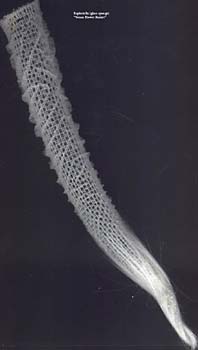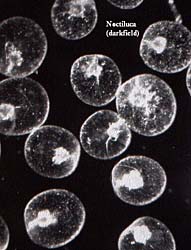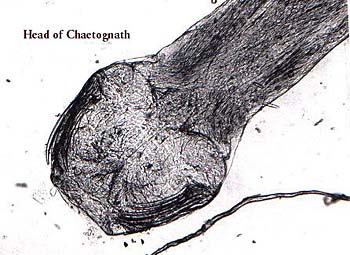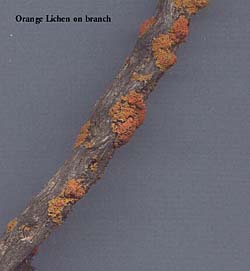(Images with pink borders can be clicked to see a larger view.)
For over 50 years now, I have had difficulty seeing the world the way other people do. Once I got my first glimpse through a microscope, I was dazzled and hopelessly addicted.
It's spring here and the lilacs are in bloom and, as I sit here at the kitchen table writing this, I am looking at a vase full of lilacs. (Actually it's not a vase, but a one liter pharmaceutical beaker.) They have a lovely, strong fragrance and I sometimes fantasize about being able to "see" fragrances. Others look at the bunches of delicate lavender-colored flowers and remark on their beauty, but I want to take the tiny individual flowers and probe into their secrets with my microscopes. Other people hardly notice their leaves—just sort-of-elongated heart-shaped leaves, but to me they are a bundle of mysteries to be investigated.
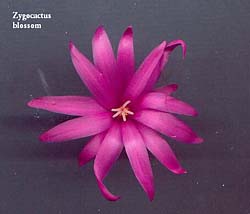
Zygo cactus blossom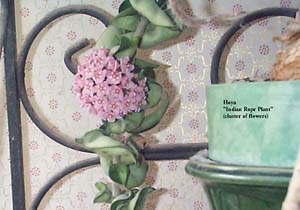
Hoya 'Indian rope plant'. Cluster of flowers.
My lovely, tolerant and indulgent wife of 41 years, graciously permits my snipping blooms from her violets, zygocacti, and from the wondrous wax-like flowers from her hoyas. Over the years, nearly everything I encounter has become a potential subject for microscopic investigation and, in this essay, I want to ramble on a bit about some things that, at one time or another have particularly taken my fancy.
1) For some reason, I am especially attracted to vitreous materials and so silica and calcareous structures have been a source of continual delight for me. There is a wonderful sponge with the name Euplectella aspergillium, also known as the Venus Flower Basket. I have no good notion of what this sponge looks like when its alive, but its skeleton is not only pleasingly vitreous, but is one of the most beautiful objects in nature. It is a glass sponge which belongs to the group of hexactinellids which construct their skeletons, in large part, in lattices composed of complex six-pointed spicules. I have acquired several specimens and have avidly hoped that in the process of shipping, one of them would arrive broken. The reason is, of course, obvious; I want to take one of these elegant skeletons apart, bit by bit, and try to grasp the architectonics of its architecture. Alas, each one has arrived intact, in fine condition and, thus far, I have not been able to sacrifice one to the mallet. I think I shall have to incite some administrator at the university to a particularly odious piece of bureaucratic nonsense, so that in my fury, I will wield the mallet. If this happens, then, of course, I'll have to write an article about Euplectella which I will inflict upon you.
2) Imagine a creature which spends a very large portion of its life, skimming around on the surface of ponds like an ice skater, but with no ice; a creature which is a voracious predator, has feathery modified oar-like appendages, and dives like an attack plane—in short, a whirligig beetle. Perhaps its most amazing feature is its eyes which are constructed in such a manner that it has two pairs; as it skims along the surface, one eye on each side is above water scanning the surface, and the other, is below water, scanning the watery underworld—this gives a whole new meaning to the phrase "four eyes".
3) From the first time I got interested in biology as a boy, I have been intrigued by the staggering variety of shells, spicules, plates, loricas, spines, scales, envelopes, and protective coverings which nature has provided in such abundance. Some of these are constructed of silica or calcium carbonate, others of strontium carbonate, some of complex polysaccharides, some of chitin or keratin or complicated mixtures of mineral and protein compounds. In the rotifer genus Keratella, its protective envelope is mostly transparent, but there may be some sculpting visible on the surface at high magnifications. Although there is a basic type of pattern in the envelope, there is a great deal of variation on the basic theme in terms of length, width, and the relative lengths and number of the spines or spikes projecting from the envelope. These little micro-marvels look like Klingon warships. (I have long been convinced that there is a secret cult of screen writers who are amateur biologists and microscopists.—Just look at the organic forms in the sets which Giger designed for the film Alien.)
4) Another futuristic space warship architect among the rotifers is Kellicottia, especially K. longispinus. If I were designing a spaceship, this would be my inspiration. Another of my favorites is Polyarthra, which has, extending from its midriff, a row of what appear to be feathers. These are used for a remarkable form of locomotion. When you're trying to get a close-up view of these appendages, suddenly the rotifer disappears from your view. These "feathers' act like springs and allow Polyarthra to bound away from any perceived threat.
5) Another wonderful aquatic spaceship design is to be found in Ceratium hirudinella, a dinoflagellate or "armored" flagellate. This group of organisms possesses distinctive plates, sometimes with elaborate sculpting, one or more central girdles or bands, and, of course, flagella. These remarkable creatures are found in both marine and freshwater environments and under certain conditions can produce "blooms". This is especially problematic with marine forms, since many creatures feed on dinoflagellates, especially shellfish, and the ingestion of large numbers of "dinos" can infect oysters, mussels, and other such delicacies in such a way that they become toxic, even fatal, when eaten by humans.
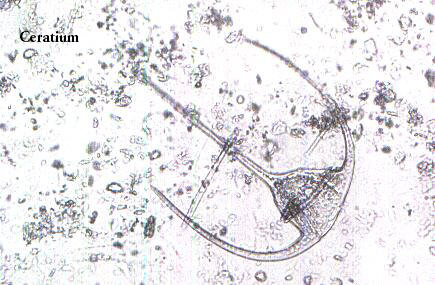
Ceratium6) A close relative, Noctiluca scintillans, looks, not like a spaceship, but more like some being that might arrive in one from some bizarre aquatic world. Noctiluca looks rather like a flattened bean-shaped leaf and the distinctive flagellum arising from the center of the "leaf" looks like a "rootlet" or sprout. The genus name scintillans is descriptive, since this organism is strikingly phosphorescent. It can be a significant contributor to the luminous nocturnal wake seen when this marvelous creature produces a "bloom".
7) Every pond watcher has seen clumps of green hair floating in the water. If you pick some of it out of the water, you will notice that it has a slightly slimy feel. Swimmers and fishermen tend not to like this lovely stuff.
Imagine a series of segments of a soda straw joined together and, within each segment, a green spiral band stretching from one end of the segment to the other. This is Spirogyra, a splendid and abundant filamentous alga. There are some shelled amoebae, Arcella for example, which will feed on these strands and they look like a tiny brown domes slowly devouring a long strand of green spaghetti.
8) Speaking of things slimy, when you're out in the deep, damp woodlands, look under leaves and rotting logs, and you will be surprised at the variety of small creatures you uncover, perhaps including some Mycetozoa or slime molds. Don't be put off by the name. These extraordinary creatures have very complex life cycles and some stages take on a giant amoeboid form (sometimes several feet long!) and, in other stages, produce beautifully delicate and intricate sporangia, some of which look like feathers, and others of which are like striated, stalked spheres, and yet others which look like tiny flowers, or some which even look like miniature cups, complete with a hemispheric lid, all on a stalk. These are absolutely, amazingly weird and wonderful organisms and every microscopist should, at some time or another, spend a bit of time examining them. If it's the middle of winter and the snow is flying—fear not!—you can grow your own. One winter, I took some rather wilted and slightly pathetic leaves from one of my wife's violets, put them in a 5" culture dish, covered them with water and, as is often the case these days, rather forgot about them. The dish had been covered to prevent evaporation and when I did get back to them, with the intent of hunting for protozoa, I noticed some molds growing on the leaves—not surprising—but I also noticed some other more gelatinous sorts of growths and—voila!—I discovered that I had inadvertently succeeded in growing some slime molds.
9) Someone once told me that the word butterfly in English was a result of transposition and that the word was originally flutterby. I probably checked, but I don't remember what I discovered and, frankly, I don't care, because I think the word "flutterby" is so wonderfully descriptive that that should have been the derivation and, furthermore, I think we should return to using it. But it won't happen and you'll just get annoyed if I keep writing flutterby instead of butterfly, so I'll stick to the convention.
Butterflies and moths are marvels in and of themselves. This afternoon I was putting up some hanging fuchsias on our front porch and two of them are near a shrub which is blooming. Suddenly I heard something whirr past me and then, there, only a foot from me, was a large hawk moth whose lower wings were pink. At first glance, I thought it was a small hummingbird and, indeed, these are sometimes called hummingbird moths. I watched this one for at least 5 minutes before he or she went darting off. The entire time it hovered, as it moved from blossom to blossom, the wings humming and the long needle-like proboscis just barely visible. I probably noticed the pink tint of the lower wings only because I had once found a dead specimen and had examined it. This aeronautical tour de force made me contemplate the enormous energy of this small creature and, I must say, made me slightly envious.
Of course, any microscopist worth his or her salt, who finds a dead butterfly or moth, will want to examine it under the microscope and indeed there are wonderful things to be found: tiny hairs, antennae which look like strings of beads, feathery antennae, the incredible coiled proboscis, but, for me, most of all, the scales. There are long flat scales with serrated tips, long and very narrow scales with a sort of bristle at the end, there is a scale of an ordinary blue moth which looks rather like a tennis racket, another moth scale which looks like a cricket bat with almost no handle, long plumed scales, and some, that in their general form, look very much like the basic design of the rotifer Keratella. Nature experiments, but apparently finds certain patterns which seem particularly effective and so they show up again and again.
10) Marine plankton is an entire universe unto itself. Years ago, while staying on the coast of Maine in the house of some friends, I had access to living plankton every day for a month. What a delight! Since then I have had to rely on preserved samples, but even these are full of wonders and marvels. Looking at a plankton sample is an exercise in humility. I have yet to look at a sample that didn't contain at least one organism I had never see before. One of the spectacular things about plankton is that not only do you get to see full-fledged, card-carrying adult organisms, but larval forms in a mind-boggling assortment of developmental stages.
Copepods of fantastic shapes and colors are sometimes abundant in various stages, as well as crab and lobster larvae, some of which show little resemblance to what they will look like as adults. One of the most bizarre instances is a parasite which infects certain species of crabs. The tail flap doesn't lie flat against the body due to an orange sac-like growth in the genital area of the crab. If you very carefully dissect the crab, you will discover a network of what appears to be rootlets extending throughout the body of the crab even up into the furthest appendage. Adult parasites are often degenerate in form, as is certainly the case with this very, very strange organism called Sacculina carini. It was only when some enterprising scientist traced the larval forms of this creature that he discovered, I think to everyone's astonishment, that this alien beastie is, in fact a barnacle!! It was the pre-Socratic philosopher, Heraclitus, who remarked that Nature loves to hide.
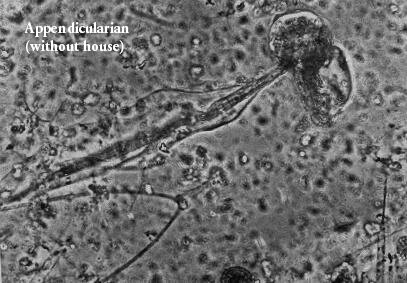
Appendicularian (without house)Noctiluca and dinoflagellates can also be abundant in plankton. Salps, doliolids, and appendicularia, which are pelagic tunicates, may also appear. Salps were using jet propulsion long before human beings appeared on the scene. The siphons of salps are located at opposites ends of their streamlined, gelatinous bodies. Most salps are so transparent that the arrangement of their internal structure is clearly visible. They take in water through the anterior or incurrent siphon, then a series of muscle bands contract—rather like your fingers closing when you make a fist—and the frontal siphon closes and the water is forced out through the posterior or excurrent siphon, propelling the salp through the water. Doliolids are also transparent and look like tiny rounded barrels containing a spiral muscle band coiled inside. I observe organisms such as salps and doliolids and come to the conclusion that somewhere in the depths of the ocean are elfin glassblowers who taught all of those fine crystal glass makers in Germany, Austria, and Czechoslovakia their splendid art.
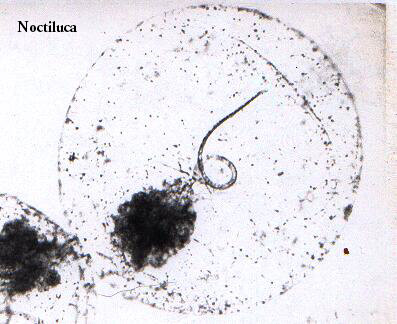
NoctilucaHowever, the prize for strange pelagic tunicates certainly has to go to the appendicularia. These are also very small organisms and strongly resemble the "tadpole" larval stage of the sessile tunicates. This incredible creature consists of 3 basic parts; a head, a tail, and a "house". Oikopleura is a typical example. The head is large in relation to its over size; the tail has a notochord—in other words, a primitive "backbone", which is why they are classified as Urochordates, just below the vertebrates! The house is a gelatinous spherical "tent" which extends out around the head and the tail. This house also contains the siphons or the filters and if the animal senses threat or if the filters become clogged, it jets itself out of its house, and then inflates a new "house" around itself, which it already has prepared!
Also to be found in marine plankton are sleek, voracious predators called chaetognaths or "arrow worms". They are not worms, but they do certainly live up to their description as "arrows" for, when they are feeding, they flash and dart with remarkable speed. They are streamlined, transparent, and usually have distinctive fins. Around the distinctive head is a series of sharp spine-like teeth on each side which are composed of chitin. Chaetognaths make wonderful objects of study.Small jelly fish and ctenophores (sea combs) are also abundant at certain times of the year and their color and variation of form can be most delightful. The combs of some of the ctenphores are iridescent and can produce a lovely display.
This list could and should go on and on, but I'll save a bunch of other things for a second list sometime. However, I can't omit the general category which first addicted me to microscopy—pond life. Streams, lakes, and rivers harbor many organisms also found in ponds, but a pond is a very special environment or perhaps it's just my idiosyncratic sensibilities. For a period of about 20 years, every summer I would roam an area about 20 miles to the east of us, in the nearby mountains, which had literally dozens of beaver ponds. Then the State began paving the graveled roads, putting in picnic benches, restrooms, trails and parking lots. For me, the area has now lost much of its charm and I rarely go there anymore. Water has been diverted, many of the ponds have silted up, most of the beaver have disappeared. Areas which were once rather remote are now overrun with people and areas which were once quiet and clean, are now assaulted by recreational vehicles the size of buses, trailers, all-terrain vehicles, motorcycles, off-road vehicles—none of which seem to have mufflers—and all of which seem to be equipped with enormously powerful quad-sound devices blasting forth what these days passes for music, at a volume that will make your ears bleed, if you get within 100 yards. There is a place about 20 miles into the mountains which has some wonderfully interesting rock formations and which was, at one time, a sacred place to the American Indians of the region. It has undergone a transformation such as I describe above and so I have avoided it for several years now. Nonetheless, I was astounded to read an account in our local paper yesterday, of a 25 year old man who was critically injured at a skateboard ramp at that location, because he wasn't wearing a helmet. Emergency vehicles responded with considerable efficiency and he was airlifted by helicopter to a larger hospital in Colorado with a special neurological unit.
He remains, at this writing, in critical condition and, so do I, in quite a different sense. At one time, there was a string of 5 or 6 beaver ponds connected by a rather contemplative little stream in that area. There was a small, but vigorous spring welling up to feed the stream. I have no idea whether it's still there or whether it's been paved over. There used to be a nice path up through the rocks, which even an unathletic sort such as myself, could navigate with minimal risk. There were small rock pools teeming with algae and fairy shrimp. There were wild raspberries to be sampled both on the way up and the way down. There were crusts of green, orange, and brown lichens on the rocks and there were extraordinary vistas—places where one could look down on meadows carpeted with wildflowers and then look up toward the southwest and see the snow-capped peaks of Rocky Mountain National Park over 100 miles away.
Some people, motivated largely, from my cynical point of view, by greed, seem to think that every scenic place should be a place of easy and ready public access, with as many amenities and entertainments as can be crowded in. Yellowstone Park is already a nightmare and, any day now, I expect to open the newspaper and read about plans to develop a multi-million dollar Yellowstone World Amusement Park.
Yes, I know. I'm a dinosaur, a cranky old curmudgeon and, in another decade or two (if I'm lucky), I won't be around to fuss and fume. But, in the meantime, I'm still concerned about ponds. When I first began looking at pond samples as a boy, I was remarkably fortunate, for some of the first creatures I encountered were among the most lovely, striking, and memorable of the micro-world. I found the stately blue Stentor, the remarkably elastic Lacrymaria whose acquaintance I have enjoyed for nearly 50- years, and Volvox, those regal green, transparent spheres making their way through their aquatic universe, utterly oblivious to human concerns.
Years later, collecting in the beaver ponds, I would turn over logs and find wonderful bright green colonies of algae and the lovely little tubiferous networks of Plumatella, a freshwater bryozoan. I used to carry a very sharp hunting knife when I went collecting and this would allow me to slice off very thin sections of the bark with the algae or bryozoan colonies on them and place them in jars of fresh pondwater for transport home.
I would place the strips of bark in small culture dishes with water from the pond and let them settle for an hour or so. Then, very gently, I would place a dish on the stage of my stereo dissecting microscope, focus on the tubes and wait. After a bit, the lovely feathery plumes would emerge from the tubes and the Plumatella would begin to feed. The tentacles are covered with thousands of cilia and create a significant current to draw in tiny bits of food. Looking very carefully at the edges of the tentacles, the action of the cilia is clearly visible. If someone offers me the choice between parking lots and Plumatella, I'll pick Plumatella every time.
All comments to the author Richard Howey are welcomed.
